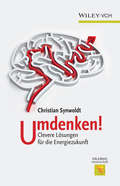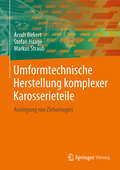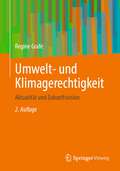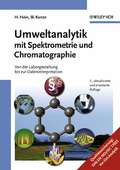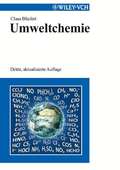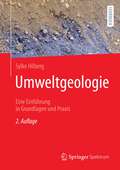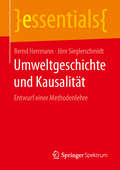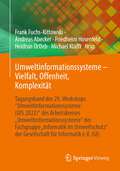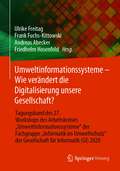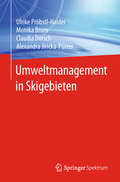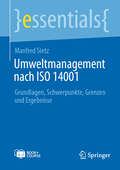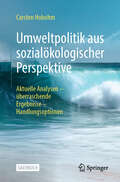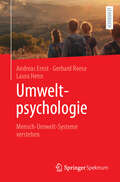- Table View
- List View
Umbilical Cord Blood Banking and Transplantation
by Karen BallenThis comprehensive volume discusses the current scope of umbilical cord blood transplantation (UCBT), including recent controversies and future developments for improving clinical outcomes. Its twenty chapters introduce new applications in regenerative medicine and discuss the latest scientific, regulatory, clinical and investigational aspects of cord blood banking. Physicians from around the world provide a global collaboration which explores strategies for umbilical cord blood expansion, homing, unit selection, and combining of graft sources to improve patient outcomes. Umbilical Cord Blood Banking and Transplantation also reviews advances in pediatric UCBT for hematologic and non-hematologic disorders as well as immune recovery, which is critical to preventing infection. Finally, it compares UCBT with other graft sources in an attempt to understand the optimal graft source for the individual patient. UCBT is an important option for many patients who need a transplant but do not have a family donor or a matched unrelated donor. The collective and timely knowledge presented here is essential reading for any regenerative medicine investigator, cord blood banker, transplant laboratory scientist or clinical physician interested in improving and expanding the applications of umbilical cord blood.
Umdenken!: Clevere Lösungen für die Energiezukunft (Erlebnis Wissenschaft)
by Christian SynwoldtAusgereizte oder ausgereifte Argumente?: Christian Synwoldt bietet sachliche Orientierung in einer emotional geführten Energiedebatte Natürliche Ressourcen für die Energiegewinnung werden knapp - wir wissen das. Doch was tun? Sind neue Technologien und Energieeffizienz der Königsweg zu einer nachhaltigen Energieversorgung? Können Kohlekraftwerke der nächsten Generation klimaneutral arbeiten? Ist Photovoltaik der Heilige Gral der Stromerzeugung? Oft gibt es auf diese Fragen nur einseitige, interessengeleitete Antworten. Christian Synwoldt zeigt nun in seinem Buch Umdenken: Clevere Lösungen für die Energiezukunft, Hintergründe und Details, die in der Diskussion um eine nachhaltige Energieversorgung regelmäßig unter den Tisch fallen und stellt dabei bequeme Standpunkte in Frage. Im Fokus: Ökologische, wirtschaftliche, politische und gesellschaftliche Folgen In den Mittelpunkt stellt der Autor die ökologischen, wirtschaftlichen, politischen und gesellschaftlichen Folgen des (unvermeidbaren) Umbaus der Energieerzeugung - und nicht etwa die (vermeintlichen) Vor- und Nachteile bestimmter Technologien. Synwoldt befasst sich neben den überaus erfolgreichen Errungenschaften auch mit den negativen Konsequenzen des Erneuerbare-Energien-Gesetzes und den Umtrieben an der Leipziger Strombörse. Ebenso geht er auf die oft verschwiegenen Probleme des Netzausbaus und die unaufrichtigen Argumente beim Kostenvergleich zwischen konventioneller und regenerativer Stromerzeugung ein. So hinterfragt er auch allseits bekannte Aussagen wie: Der Ausstieg aus der Kernenergie führt zu höheren Strompreisen Synwoldt sprengt so manche Argumentationskette In dem Kapitel Alter Wein in neuen Schläuchen fragt Christian Synwoldt nach den Möglichkeiten von New Oil und New Gas, von Kohlestrom und Kernkraft. In dem Kapitel Die Zukunft hat bereits begonnen stellt er dann die Energiewende ganz in den Mittelpunkt, um im Anschluss Aspekte der Wirtschaftlichkeit und Effizienz zu diskutieren. Das Buch Umdenken: Clevere Lösungen für die Energiezukunft stellt gewohnte Ansichten auf den Prüfstand und sprengt so manche Argumentationskette. Der Autor schildert und bewertet die gesellschaftlichen, politischen und ökonomischen Voraussetzungen einer gelingenden, echten Energiewende und gibt dem Leser schlagkräftige Argumente für die Energiediskussion an die Hand.
Umformtechnische Herstellung komplexer Karosserieteile: Auslegung von Ziehanlagen
by Arndt Birkert Stefan Haage Markus StraubAn komplexe Karosserie-Blechformteile werden seitens der Automobilindustrie allerhöchste Anforderungen hinsichtlich Funktionalität und Oberflächenqualität gestellt. Um diese Anforderungen zu erfüllen, wird ein entsprechender Methodenplan entwickelt. Das geplante Werk führt zunächst in Grundlagen von Karosseriebau, Umform- und Werkstofftechnik, Werkzeugtechnik und Pressentechnik ein, soweit diese für die Herstellung von Karosserieteilen relevant sind. Auf Basis dieser Grundlagen wird im Hauptteil die Thematik der Methodenplanung behandelt, wobei der komplexe Planungsprozess zunächst auf ein sequentielles Gedankenmodell herunter gebrochen wird. Schließlich wird anhand von Praxisbeispielen aufgezeigt, wie die zuvor sequentiell behandelten Planungsschritte zum Teil gleichzeitig, zum Teil nacheinander in mehreren Iterationsschleifen in der Praxis abgearbeitet werden. Bei allen Ausführungen steht stets die Erfüllung der qualitätsmäßigen Anforderungen, die heute an moderne Karosserieteile gestellt werden, im Vordergrund.
Umwelt- und Klimagerechtigkeit – Gesundheit und Wohlbefinden: Energiegewinnung und Energienutzung (essentials)
by Regine GrafeIm Kontext von Umwelt- und Klimagerechtigkeit werden Umweltzerstörung und Klimastörung kritisch hinterfragt. Dabei wird sowohl auf die geodynamisch bedingten als auch auf anthropogene Störungen in der Erdatmosphäre eingegangen. Der in diesem Zusammenhang vieldiskutierte Treibhauseffekt wird verständlich erläutert. Es wird verdeutlicht, dass für die Störungen der Wärmebalance der Erdatmosphäre eine exorbitante Ressourcenausbeutung wie Bodenversiegelung durch Bebauung, Energiegewinnung und weitere anthropogenen Beeinflussungen verantwortlich sind, woraus humanbiologische Konsequenzen mit Gesundheitsrelevanz folgen. Ursachen und Wirkungen der spürbaren Klimaveränderung - auch Klimawandel genannt - werden vor dem Hintergrund humanbiometeorologischen Einwirkungen auf die Gesundheit allgemeinverständlich dargelegt. Das umfasst auch das zunehmende Problem von sich ausbreitenden Klimafolgern wie eine Vielzahl stechender Insekten, die für eine Verbreitung von Infektionskrankheiten sorgen, und Pflanzen mit allergenem Potenzial.
Umwelt- und Klimagerechtigkeit: Aktualität und Zukunftsvision
by Regine GrafeEs wird die Komplexität von Umweltverschmutzung und Gesundheitsbeeinträchtigung im Kontext von sozialer Indikation dargestellt. Mit Hilfe von Sozialindikatoren wird aufgezeigt, wie Umweltverschmutzung, Gesundheitszustand, Bildungsteilhabe und Arbeitswelt auf die Menschen, insbesondere in Ballungsgebieten und in ausgewählten Innenstadtbereichen sowie in Satelitenstädten unmittelbar zusammenhängen. Die Bewertungsgrößen Predicted Mean Vote (PMV) und Physiological Equivalent Temperature (PET) werden im Kontext der Humanbiometereologie (HBM) ausführlich diskutiert Stadtklimatologie und Geometrie der Stadtarchitektur werden in Hinblick auf die urbane Gesundheit und die soziale Beeinflussungen der Bewohner dargestellt.
Umwelt- und Klimagerechtigkeit: Digitalisierung, Energiebedarfe, Klimastörung und Umwelt(un)gerechtigkeit (essentials)
by Regine GrafeDer Zusammenhang von Umweltzerstörung und Klimastörung infolge der sich rasant entwickelnden Digitalisierung in allen Lebensbereichen der Menschen wird kritisch hinterfragt. Der Energiebedarf für die aktuell weltweit genutzten digitalen Endgeräte bewegt sich derzeit im Terra-Watt-Bereich. Diese Energiemenge wird noch immer mehrheitlich aus fossilen Energiequellen gewonnen, gefolgt von biologischen Quellen wie Mais, Raps, Getreide, Palmen und weitere. Der sich rasant entwickelnde Plattformkapitalismus der GAFA-Monopole und weiteren hat zu einem Anstieg des Energiebedarfs für digitale Endgeräte gesorgt. Die Folgen sind eine vermehrte Freisetzung von Treibhausgasen und vor allem von Abwärme, die einen nicht unmaßgeblichen Anteil der Störung der Wärmebalance und damit der Klimastörung hat. Digitalisierung bewirkt darüber hinaus auch gesellschaftliche Veränderungen wie neue Arbeitsmodelle und Arbeitszeitmodelle und erfordert neue, nämlich digitale, Kompetenzen. Der damit verbundene Einschnitt in die gesellschaftlichen Strukturen zeigt sich bereits in einer steigenden Vereinzelung der Menschen, die mit Identitätsverlust, Verhäuslichung und Desozialisation einhergeht.
Umweltanalytik mit Spektrometrie und Chromatographie: Von der Laborgestaltung bis zur Dateninterpretation
by Wolfgang Kunze Hubert HeinDer bewährte Wegweiser für erfolgreiche Umweltanalytik, jetzt in einer vollständig überarbeiteten und erweiterten Neuauflage! Die neue, dritte Auflage behandelt insbesondere auch Aspekte der Wirtschaftlichkeit sowie in einem eigenen Kapitel die Methoden der Vor-Ort-Analytik. Jeder Laborleiter kann sich mit diesem einzigartigen Handbuch kompakt, aktuell und gezielt über den Stand des Labormanagements sowie der anerkannten spektrometrischen und chromatographischen Methoden informieren. Die Aufgaben des Laborleiters werden von der Planung der Laborräume bis zur Dokumentation der Analysen beschrieben. Dazu zählen insbesondere die Themen - Umweltgesetzgebung - Probenahme und Probenvorbereitung - Bezugsquellen für anerkannte Analysenmethoden Besonderes Merkmal: Durch das Griffregister hat der Benutzer leichten Zugang zu übersichtlichen Tabellen. Sie sind nach Parameter, Umweltkompartiment und Aggregatzustand gegliedert und ermöglichen das rasche Auffinden einer anerkannten Analysenmethode. Aus Rezensionen der vorigen Auflagen: "Genau auf die Bedürfnisse der Laborleiter zugeschnitten" Fachinformationszentrum Karlsruhe "Hubert Hein und Wolfgang Kunze haben ein neuartiges Buch geschrieben. Was die Verfasser in besonderem Maße auszeichnet: Sie wissen aus eigener Tätigkeit und vielfacher Erfahrung, worüber sie schreiben. Es handelt sich um eine Monographie, die im Fachschrifttum nicht mehr wegzudenken sein wird." Deutsche Gewässerkundliche Mitteilungen
Umweltchemie
by Claus BliefertAuch in seiner dritten Auflage besticht dieses Lehrbuch durch seine verst ndliche Darstellung und die einpr gsamen Abbildungen, die die komplexe Materie nicht nur dem Studenten nahebringen. Der Inhalt wurde fur die neue Auflage durchgehend aktualisiert und um wichtige neue Aspekte des Umweltrechts erg nzt. Stimmen zum Buch: ..".ein umfassender, flott zu lesender Einstieg in das weite Feld der Umweltchemie." (Nachrichten aus der Chemie) "Zahlreiche Tabellen und Grafiken helfen beim Verstehen der Zusammenh nge." (Umwelt Magazin) "Besonders erw hnenswert ist das umfangreiche Register. [Dieses] verleiht dem Buch beinahe einen lexikalen Charakter." (Advances in Food Sciences) "Durch seinen durchg ngien Praxisbezug ... bietet das Buch auch dem in der Industrie t tigen Praktiker ein umfassendes Nachschlagewerk zu den Fragen des Umweltschutzes." (Aluminium)
Umweltchemie: Eine Einfuhrung mit Aufgaben und Losungen
by Ronald A. Hites Jonathan D. Raff Peter WiesenEin schneller Einstieg in die Umweltchemie, fachlich fundiert und mit Praxisbezug? Die vorliegende �bersetzung des amerikanischen Bestsellers Elements of Environmental Chemistry macht es m�glich. Hier werden die Schwerpunkte der Umweltchemie auf den Punkt gebracht: Welche Faktoren verursachen die Klimaerw�rmung? Wo n�tzt Ozon und wo schadet es? Wie verhalten sich schwer abbaubare Substanzen, wenn sie in die Umwelt gelangen? Erg�nzt um aktuelle Beispiele aus Deutschland und Europa vermittelt das einf�hrende Lehrbuch Grundlagen und Anwendungen des chemischen Verhaltens von Stoffen in der Umwelt. Zahlreiche Beispielrechnungen trainieren den Umgang mit chemischen Gr��en. Den Bezug zur Praxis stellen die �ber 150 �bungsaufgaben her, und der Lernerfolg kann gleich im L�sungsteil �berpr�ft werden. Ein Grundlagenbuch und ein Werkzeugkasten, der Bachelor-Studenten mit dem notwendigen Wissen ausr�stet. Das ideale Einsteigerbuch f�r Studierende aller Fachrichtungen.
Umweltgeologie: Eine Einführung in Grundlagen und Praxis
by Sylke HilbergDie Umweltgeologie befasst sich mit den Auswirkungen von menschlichen Aktivitäten auf die geologische Umwelt. Im Kontext von Klimawandel und Biodiversitätskrise scheint die Geologie auf den ersten Blick nur eine Nebenrolle zu spielen, ist sie doch die Wissenschaft, die sich mit der Erdkruste und allem, was darunterliegt, befasst. Dieses Lehrbuch bietet einen ausführlichen Überblick, welchen Beitrag die Umweltgeologie dazu leisten kann, negative Auswirkungen der aktuellen Veränderungen unserer Umwelt einzudämmen, bereits entstandene Umweltschäden zu sanieren und zukünftige zu verhindern.Dazu betrachtet der Grundlagenteil das geschlossene System Erde und die verschiedenen Teilbereiche Atmosphäre, Hydrosphäre, Pedosphäre und Lithosphäre. Die wichtigsten Stoffgruppen werden vorgestellt und geogene, aber auch anthropogen induzierte Stoffflüsse über die Grenzen der Lithosphäre hinweg diskutiert. Der Praxisteil stellt die wichtigsten Methoden der Umweltgeologie vor und unterzieht verschiedene Bereiche der angewandten Geologie einer Emissionsbetrachtung. Der Fokus liegt dabei auf Altlasten, Rohstoffen, Wasser und Energiebedarf. Die Vermittlung von Faktenwissen wird durch Fallbeispiele aus der Praxis der Autorin unterstützt. Die vorliegende zweite Auflage greift neue Erkenntnisse im Fachgebiet auf und ist ergänzt durch neue, wertvolle Erfahrungen der Autorin seit dem Erscheinen der ersten Auflage. Diese Einführung bietet Studierenden der Geowissenschaften und Biologie einen gut verständlichen Einstieg in die Umweltgeologie. Sie erklärt etablierte Lösungsansätze, zeigt aber auch bisher ungelöste Probleme im Wechselspiel von Mensch und Geologie auf. Dazu gehören zum Beispiel Fragen rund um „grüne Technologien“ der Energiewende oder auch Gewinnung und Einsatz von „Hightech-Rohstoffen“ und die damit verbundenen Umweltauswirkungen. Das Buch bietet damit eine Orientierung bei der kritischen Auseinandersetzung mit einigen der brennenden Fragen unserer Zeit.
Umweltgerechtigkeit: Arbeit, Sozialisation, Teilhabe und Gesundheit (essentials)
by Regine GrafeUnter Einbindung des Umweltgerechtigkeitsansatzes, der die Gesundheitsgerechtigkeit impliziert, werden Fragen zur Bedeutung von non-formaler und formaler Bildung im Kontext der Sozialisation des Einzelnen in einer sich verändernden Gesellschaft gestellt. Wieviel und vor allem welche Art von Teilhabe ermöglicht die Gesellschaft aktuell und vor welchen Herausforderungen steht sie in Zukunft? Welche zukunftsfähigen Bildungsinhalte müssen vermittelt werden für die sich aktuell rasant verändernde Gesellschaft? Es bedarf nicht nur neuer Wissens- und Kompetenzvermittlung, sondern auch eines Paradigmenwechsels beim Arbeitsschutz. Was bedeutet das für die Gesellschaft und den Einzelnen? Es geht dabei auch um Assimilation, Integration und Onboarding. Wer wird die notwendigen Bildungsinhalte zukünftig vermitteln und mit welchem Anspruch? Welche Rolle wird die Arbeits(um)welt dabei spielen? Fragen, die aktuell gestellt werden müssen, um gesellschaftspolitische Antworten darauf zu finden.
Umweltgerechtigkeit: Zusammenhang, Verantwortung und Stellschrauben (essentials)
by Regine GrafeAusgehend vom Konzept des „Sozialen Raumes“, der im ganzheitlichen Begriff der Umwelt verankert ist, stellen sich Fragen nach dem Einfluss sozialer Räume auf den Menschen. Welchen Einfluss haben Lern- und Arbeitsumwelt? Wie ist es mit Chancengleichheit des Einzelnen und seiner Teilhabe bestellt? Wie hängen Wissen und Bildung zusammen? Nicht jeder, der viel weiß, ist auch gebildet. Welche Bedeutung hat die antizipatorische Bildung in der Familie und welche der Arbeits-, Lern- und Lebensumwelt? Fragen, die zweifelsohne mit sozioökonomischen Bedingungen eng zusammenhängen. Aber ist das ausschließlich darauf zu reduzieren? Wie wird die Zukunft der Arbeitswelt als Wissenswelt und damit deren Einfluss auf den Einzelnen aussehen? Welche Kompetenzen werden erforderlich sein für diese neue Arbeitswelt und wer wird sie vermitteln? Welche Bildungsinhalte werden deren soziale Räume vermitteln und mit welchem Ziel? Wenn Wissen zur Ware wird und damit beliebig, wer übernimmt dann die Verantwortung für dessen Vergegenständlichung als Produkt?
Umweltgeschichte im Überblick (essentials)
by Bernd Herrmann Jörn SieglerschmidtBernd Herrmann und Jörn Sieglerschmidt erläutern die gedanklichen Grundlagen der Umweltgeschichte. Sie zeigen auf, dass durch Menschen beeinflusste Ökosysteme, wie alle Entwicklungen in der Zeit, eine Geschichte haben. Ihre ausschließliche Zuordnung zu den Natur- oder Geschichtswissenschaften ist daher nicht sinnvoll – Umweltgeschichte ist nur als Synthese aus beiden zu verstehen. Konkreter Gegenstand der Umweltgeschichte ist die Analyse der Beziehungen zwischen Menschen und den von ihnen genutzten naturalen Ressourcen im historischen und kulturellen Wandel. Der Blick in die Geschichte der Umweltverhältnisse ist Teil einer ökologischen Grundbildung und belehrt über mögliche langzeitige Folgen umweltwirksamen Handelns.
Umweltgeschichte in Beispielen (essentials)
by Bernd Herrmann Jörn SieglerschmidtDieses essential widmet sich der Umweltgeschichte als Darstellung des Verh#65533;ltnisses von Menschen zu ihrer Umwelt in historischer Perspektive. Die Autoren behandeln auf der Basis exemplarisch ausgew#65533;hlter Abbildungen relevante Fragen und Problemfelder der Umweltgeschichte. Diese reichen vom wissenschaftshistorischen #65533;ber den wissenschaftssystematischen Kommentar bis hin zu Anmerkungen einzelner historischer Umweltszenarien mit exemplarischem Charakter. Der Leser erf#65533;hrt, warum Umweltgeschichte ein unverzichtbarer Bestandteil der #65533;kologischen Orientierung und Grundbildung sowie das Fundament jeder Kulturgeschichte ist.
Umweltgeschichte und Kausalität: Entwurf einer Methodenlehre (essentials)
by Bernd Herrmann Jörn SieglerschmidtBernd Herrmann und Jörn Sieglerschmidt konzentrieren sich auf wissenschaftstheoretische und wissenschaftsmethodische Fragen, einen bisher stark vernachlässigten Bereich in der Umweltgeschichte. Die Autoren beginnen mit den umwelthistorischen Anfangs- bzw. Erstereignissen. Entsprechend der unterschiedlichen Zugänge der Umweltgeschichte zu ihren wissenschaftlichen Gegenständen – den naturwissenschaftlichen einerseits und den gesellschafts- und geisteswissenschaftlichen andererseits – müssen unterschiedliche Kausalitätsmodelle Berücksichtigung finden. Die Diskussion verbindet methodisch wie theoretisch eine materialistische mit einer idealistischen Auffassung. Der vorliegende Band ergänzt die bereits erschienenen essentials „Umweltgeschichte im Überblick“ und „Umweltgeschichte in Beispielen“ desselben Autorenteams.
Umweltinformationssysteme - Wie trägt die Digitalisierung zur Nachhaltigkeit bei?: Tagungsband des 28. Workshops “Umweltinformationssysteme (UIS 2021)“ des Arbeitskreises „Umweltinformationssysteme“ der Fachgruppe „Informatik im Umweltschutz‘‘ der Gesellschaft für Informatik (GI)
by Frank Fuchs-Kittowski Andreas Abecker Friedhelm HosenfeldDer neueste Stand der Forschung und Entwicklung auf dem Gebiet der Umweltinformatik (UI) und umweltbezogener IT-Anwendungsbereiche wird in diesem Tagungsband präsentiert und kritisch diskutiert. Dies umfasst sowohl Konzepte und Anwendungen von Umweltinformationssystemen als auch Technologien, die moderne Umweltinformationssysteme unterstützen und ermöglichen.
Umweltinformationssysteme – Vielfalt, Offenheit, Komplexität: Tagungsband des 29. Workshops “Umweltinformationssysteme (UIS 2022)“ des Arbeitskreises „Umweltinformationssysteme“ der Fachgruppe „Informatik im Umweltschutz‘‘ der Gesellschaft für Informatik e.V. (GI)
by Frank Fuchs-Kittowski Andreas Abecker Friedhelm Hosenfeld Heidrun Ortleb Michael KlafftDer neueste Stand der Forschung und Entwicklung auf dem Gebiet der Umweltinformatik (UI) und umweltbezogener IT-Anwendungsbereiche wird in diesem Tagungsband präsentiert und kritisch diskutiert. Dies umfasst sowohl Konzepte und Anwendungen von Umweltinformationssystemen als auch Technologien, die moderne Umweltinformationssysteme unterstützen und ermöglichen.
Umweltinformationssysteme – Wie verändert die Digitalisierung unsere Gesellschaft?: Tagungsband des 27. Workshops des Arbeitskreises „Umweltinformationssysteme“ der Fachgruppe „Informatik im Umweltschutz‘‘ der Gesellschaft für Informatik (GI) 2020
by Frank Fuchs-Kittowski Ulrike Freitag Andreas Abecker Friedhelm HosenfeldDurch welche Methoden und Techniken der (Umwelt-)Informatik sind Fachverfahren in einzelnen Informationssystemen adäquat zu unterstützen? Wie ist das Zusammenspiel mehrerer Umweltinformationssysteme zur Beantwortung weitergehender Fragestellungen zu organisieren? Aktuelle Forschungsergebnisse, Anwendungen und Lösungen, aber auch Forschungsideen und neue Ansätze werden in diesem Tagungsband präsentiert und kritisch diskutiert.
Umweltmanagement in Skigebieten
by Ulrike Pröbstl-Haider Monika Brom Claudia Dorsch Alexandra Jiricka-PürrerDas vorliegende Buch zeigt, welche ökonomischen, ökologischen und rechtlichen Vorteile für Unternehmen entstehen, wenn sie die sensible Bergwelt so schonend wie möglich nutzen. Einsparpotenziale werden ebenso thematisiert wie ökologische Verbesserungen durch Pistenpflege oder Maßnahmen zum Vogelschutz. Ausführlich kommen auch die innerbetrieblichen Effekte zur Sprache, wie ein erhöhtes Engagement der Mitarbeiter durch die Beteiligung am Umweltmanagementsystem.Dieses Buch soll dazu beitragen, die Anzahl zertifizierter Skigebiete zu erhöhen sowie eine generelle Sensibilität für umwelt- und ressourcenschonendes Management in Wintersportgebieten zu erzeugen. Skigebietsbetreiber, Kommunen und beteiligte Planungs- und Beratungsbüros finden hier wertvolle Hinweise und Checklisten, die den Weg zu einem naturverträglichen Skigebietsmanagement erleichtern. Die Ausführungen werden durch Praxisbeispiele aus diversen Skigebieten anschaulich illustriert.
Umweltmanagement nach ISO 14001: Grundlagen, Schwerpunkte, Grenzen und Ergebnisse (essentials)
by Manfred SietzUmweltmanagement eines Unternehmens bedeutet, die Umweltauswirkungen minimierend zu managen, um die Qualität unserer Umwelt zu erhalten oder zu verbessern. Managen bedeutet in der Originalübersetzung etwas zu verwalten. Also eine Aufgabe mit Verantwortung, Zielen und Aktivitäten. Alle diese Managementtools werden zuzusammengefasst in der weltweit gültigen und zertifizierbaren Norm ISO 14001.
Umweltmikrobiologie
by Walter Reineke Michael SchlömannIn diesem Fachbuch werden die globalen und lokalen Umweltprobleme sowie die Beteiligung von Mikroorganismen an der Entstehung und Beseitigung dieser Probleme angesprochen. Insbesondere werden methodische, teils molekulargenetischen Aspekte zur Untersuchung mikrobieller Lebensgemeinschaften berücksichtigt. Insgesamt wird die herausragende Rolle der Mikroorganismen in verschiedenen Stoffkreisläufen dargestellt. Neben biochemischen Grundlagen zum Abbau von Umweltschadstoffen wird der Einsatz von Mikroorganismen in umweltbiotechnologischen Verfahren zur Reinigung von Luft, Wasser oder Boden sowie in umweltschonenden Produktionsverfahren diskutiert. Gedacht ist das Buch für Biologen mit Interesse an umweltmikrobiologischen Fragen, aber auch für Studierende der Verfahrens- oder Umweltverfahrenstechnik, der Geoökologie oder Geologie sowie Studierende anderer umweltwissenschaftlicher Fachrichtungen. Für die 3. Auflage haben die Autoren das Buch komplett durchgearbeitet, korrigiert, aktualisiert und ergänzt.
Umweltpolitik aus sozialökologischer Perspektive: Aktuelle Analysen - überraschende Ergebnisse - Handlungsoptionen
by Carsten HobohmAngesichts einer zunehmend bedrohlichen Kulisse stellt sich die Frage, wie der Klimawandel, die Intensivierung der Nutzung von Ökosystemen und die Bedrohung der Artenvielfalt das soziale und kulturelle Leben beeinflussen. In den Medien haben Katastrophenmeldungen zweifellos zugenommen. Doch in welcher Weise das gesellschaftliche Leben oder die Menschheit insgesamt durch Umweltkatastrophen konkret bedroht ist, wird bislang nur selten in ausreichender Detailschärfe dargestellt. Mit dieser Analyse wird versucht, den Knoten der gelegentlich einseitigen Betrachtung zu lösen und den Blickwinkel um einige Möglichkeiten der Ausgestaltung von Zukunft zu erweitern. Eine ganze Palette von Möglichkeiten zielt darauf ab, den Fokus der global dunklen, gleichzeitig unscharfen oder sogar verschwommenen Perspektiven um positive Ansätze in der lokalen und regionalen Dimension zu erweitern. Möglichkeiten sind reichlich vorhanden, aber sie sind nicht zum Nulltarif zu realisieren.
Umweltpsychologie: Mensch-Umwelt-Systeme verstehen
by Gerhard Reese Andreas Ernst Laura HennKlimakatastrophe, Umweltkrisen, Ressourcenknappheit – und das alles mit uns Menschen mittendrin, als zentrale Ursache, aber auch als Betroffene. Wie konnte es dazu kommen und wie kommen wir da wieder heraus? Um Mensch-Umwelt-Systeme zu verstehen, bietet die Umweltpsychologie wertvolle Ansätze. Was können wir als Einzelne, was können wir gemeinsam tun, um diese Herausforderungen zu bewältigen? Warum geht es (scheinbar) nicht weiter in Richtung Nachhaltigkeit? Wie sieht ein nachhaltiges Leben denn aus und was erwartet uns in der Zukunft möglicherweise? Ist eine Entwicklung in Richtung Nachhaltigkeit überhaupt zu schaffen und wenn ja, wie? Dieses umfassende Lehrbuch zeigt, wie menschliches Handeln mit gesellschaftlichen Dynamiken und der Umwelt verknüpft ist und wie sich diese gegenseitig beeinflussen. Anhand von Alltagssituationen und aktuellen Themen veranschaulicht es umweltpsychologische Erkenntnisse und liefert gleichzeitig die natur- und umweltwissenschaftlichen Grundlagen, die für ein fundiertes Verständnis von Umweltverhalten unerlässlich sind. Zudem stellt es dar, unter welchen individuellen, sozialen und systemischen Bedingungen eine gesellschaftliche Transformation gelingen kann, die Wohlstand und Wohlbefinden im Einklang mit den planetaren Grenzen ermöglicht. Das Buch bietet auch für Interessierte aus anderen Disziplinen und aus der Praxis eine verständliche Darstellung der wissenschaftlichen Grundlagen der Umweltpsychologie.
Umweltschutz und Gefahrguttransport für Binnen- und Seeschifffahrt: Internationale, nationale und kommunale Übereinkommen
by Uwe JacobshagenDas Buch fasst die Rechtsgrundlagen auf internationaler, nationaler und kommunaler Ebene auf den Gebieten Umweltschutz und Gefahrgutrecht zusammen. Es werden Rechtsanwendungen für die Praxis dargestellt und Besonderheiten kommentiert. Der Einsatz in der Lehre ist mögliche, es kann aber auch als Fachbuch gute Dienste leisten und stellt vor allem für die Praxis einen Wissensspeicher dar.
Umweltschutztechnik und Umweltmanagement: Ein Kompendium für Studierende, Praktiker und Politiker (essentials)
by Ekbert Hering Wolfgang SchulzDie Autoren beschreiben Gefährdungspotenziale für Luft, Wasser und Boden und den globalen Klimawandel sowie Maßnahmen zur Gegensteuerung. Sie stellen Konzepte zur Abfallwirtschaft vor und verweisen auf die Verankerung des Umweltschutzes in Unternehmen durch ein effizientes Umweltmanagement und einer Ökobilanz. So können Leser die globale Aufgabe, die Umwelt zu schützen, mit nationalen und internationalen politischen Rahmenbedingungen und vor allem dem Wissen im Bereich der Naturwissenschaften einschätzen und Umweltschäden vermeiden oder ihre Auswirkungen verringern. Die Politik schafft dazu auf nationaler, europäischer und internationaler Ebene mit Gesetzen, Regelungen und Normen die Voraussetzungen.Die AutorenDr. rer. nat. Dr. rer. pol. Dr. h.c. Ekbert Hering lehrt und forscht an der Hochschule Aalen. Er ist Verfasser erfolgreicher Fachbücher in renommierten Verlagen. Dr. rer. nat. Wolfgang Schulz ist Leiter der Forschung und Entwicklung Sonderanalytik beim Zweckverband Landeswasserversorgung und Lehrbeauftragter an der Hochschule Aalen.

